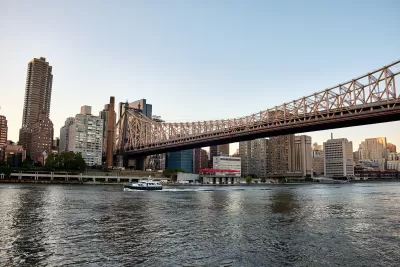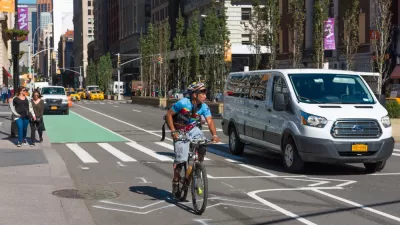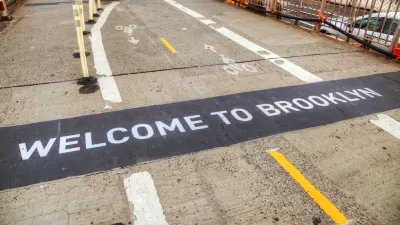A project that would give pedestrians their own dedicated path on the crowded bridge has been pushed back to at least the summer of 2024.

Pedestrians and cyclists who use New York’s busy Queensboro Bridge will have to wait at least another year to have their own dedicated lanes on the bridge, reports Julianne Cuba in Streetsblog NYC. Cyclists and pedestrians are currently forced to share the narrow north outer roadway, which has become increasingly crowded as the popularity of biking grows, creating dangerous conditions and leading to collisions.
The delay is the fourth for the project, which was originally scheduled for completion in 2022. “Ex-Mayor Bill de Blasio in 2021 promised to turn the more than century-old span’s south outer roadway into a full-time pedestrian path by the end of 2022. But that deadline came and went, and now his successor, Mayor Adams, continues to push back the schedule.”
DOT officials vaguely blamed “supply chain” and materials problems. Meanwhile, Council member Julie Won “questioned why the DOT can’t just cede the south outer roadway to pedestrians during ongoing reconstruction of the upper car lanes, but [DOT First Deputy Commissioner Margaret Forgione] claimed that removing another lane for service to car drivers would cause too much congestion.”
FULL STORY: Not Again: Queensboro Bridge Pedestrian Path Delayed Til ‘Mid-2024’

Study: Maui’s Plan to Convert Vacation Rentals to Long-Term Housing Could Cause Nearly $1 Billion Economic Loss
The plan would reduce visitor accommodation by 25,% resulting in 1,900 jobs lost.

North Texas Transit Leaders Tout Benefits of TOD for Growing Region
At a summit focused on transit-oriented development, policymakers discussed how North Texas’ expanded light rail system can serve as a tool for economic growth.

Why Should We Subsidize Public Transportation?
Many public transit agencies face financial stress due to rising costs, declining fare revenue, and declining subsidies. Transit advocates must provide a strong business case for increasing public transit funding.

How to Make US Trains Faster
Changes to boarding platforms and a switch to electric trains could improve U.S. passenger rail service without the added cost of high-speed rail.

Columbia’s Revitalized ‘Loop’ Is a Hub for Local Entrepreneurs
A focus on small businesses is helping a commercial corridor in Columbia, Missouri thrive.

Invasive Insect Threatens Minnesota’s Ash Forests
The Emerald Ash Borer is a rapidly spreading invasive pest threatening Minnesota’s ash trees, and homeowners are encouraged to plant diverse replacement species, avoid moving ash firewood, and monitor for signs of infestation.
Urban Design for Planners 1: Software Tools
This six-course series explores essential urban design concepts using open source software and equips planners with the tools they need to participate fully in the urban design process.
Planning for Universal Design
Learn the tools for implementing Universal Design in planning regulations.
Ascent Environmental
Borough of Carlisle
Institute for Housing and Urban Development Studies (IHS)
City of Grandview
Harvard GSD Executive Education
Toledo-Lucas County Plan Commissions
Salt Lake City
NYU Wagner Graduate School of Public Service





























